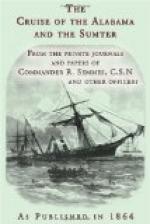Shortly after the Atlas arrived, a boat brought up some of the prisoners from Saldanha Bay, and amongst them one of the crew of the Alabama, who said he had left the ship. All these waited on the United States Consul, but were unable to give much information beyond what we had already received. The news that the Alabama was coming into Table Bay, and would probably arrive about four o’clock this afternoon, added to the excitement. About noon a steamer from the north-west was made known by the signal-man on the hill. Could this be the Alabama? or was it the Hydaspes, from India, or the Lady Jocelyn, from England? All three were now hourly expected, and the city was in doubt. Just after one it was made down, “CONFEDERATE STEAMER ALABAMA, FROM THE N.W., AND FEDERAL BARQUE FROM THE S.E.” Here was to be a capture by the celebrated Confederate craft, close to the entrance of Table Bay. The inhabitants rushed off to get a sight. Crowds of people ran up the Lion’s-hill, and to the Kloof-road. All the cabs were chartered—every one of them; there was no cavilling about fares; the cabs were taken and no questions asked, but orders were given to drive as hard as possible. The barque coming in from the south-east, and, as the signal-man made down, five miles off; the steamer, coming in from the north-west, eight miles off, led us to think that the Kloof-road was the best place for a full view. To that place we directed our Jehu to drive furiously. We did the first mile in a short time; but the Kloof-hill for the next two and-a-half miles is up-hill work. The horse jibbed, so we pushed on, on foot, as fast as possible, and left the cab




